Ferrules
Site Navigation Menu
Effects of Friction
For something we all experience countless times every day from walking across carpet to using car brakes friction is a devilishly hard subject that
you could loose yourself in the detail of but for ferrules all we care about is the co-efficient of friction and the force the slide exerts upon the
insert and we don't even need to know the actual values, only the way they fit together and slide apart. In the case of ferrules it's important the material does not gall and it should last a long time as you can't lubricate them in use and you don't
want to replace them either.
Nickel Silver is good for this, AMS4640 Nickel Aluminium Bronze is better because it's an industrial material made for the job which is especially
good as it has a low propensity to gall when used as a self mating material in the dry state.
So now we have the friction side of things squared away where does the force part of the equation come in?
The friction and the force (fit) are the only two factors when it comes to the male slide fit and the ultimate lifespan of the ferrules assuming the
ferrules material is up to the job.
Why does this matter? Because the male slide dimension has to be defined.
Because the surface area of the slide doesn't matter provided the fit is good you don't need an overly long slide to work and you could make the
slide very short indeed as they are in a Micro ferrule but the fit does have to be be very good on such a short slide because there isn't much
slide to level out variations in dressing it.
Email: AV Young avytasmania@gmail.com
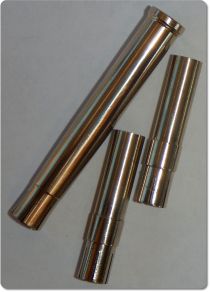
It's counter intuative but true that friction is not dependent upon the surface area of a given object but is entirely dependent upon what is known as
the co-efficient of friction
The co-effiecient of friction could be almost zero such as the friction between the sharp steel blades of skates on ice or almost 1 between the
tarmach of a dry highway and your car tires but everything experiences friction between itself and whatever it is being dragged across and that includes
ferrules no matter what material they are made of. Otherwise they wouldn't work as ferrules but you don't want to overdo things and use the wrongs material.
The formula for determining static friction is in written form:
(magnitude of friction) = (co-efficent of friction) x (magnitude of normal force).
As you can see there is no mention of surface area. The co-efficent of friction is the total friction felt between the two surfaces in contact,
the magnitude of normal force in the case of ferrules is just the tightness of fit.
The co-efficient of friction is determined by placing the two objects together and measuring the force required to *just* start them moving.
This force known as the point of impending motion is greater than that required to keep the objects moving once started as beyond that they are now experiencing kenetic
friction but this does not concern us for ferrules because we want them to remain in place until we wish to part them.
(stiction) between two surfaces and the force applied bewteen those two surfaces in our case of ferrules in a dry state.
The force experienced by the ferrules is the fit you as a rod maker dress the ferrules to. Tight fit and a lot of force, loose fit and less force, simple as that.
So a happy medium has to be found and that in the case of the 13/64th regular ferrules is 18mm. Longer means more unnecessary work dressing it, shorter more likely hood of a poor fit if you slip a bit when dressing it.
The remainder of the ferrule lengths is to allow for tabs, glue which unlike friction is affected by surface area and again aesthecis because that matters too.
To begin with we'll adress a set of Regular Ferrules and some basic concepts are explained using these so sorry it's a bit verbose.
Please note that all dimensions are mixed metric and inch. I work in metric but dimensions used for ferrule sizing are in inches (13/64th for eg.)
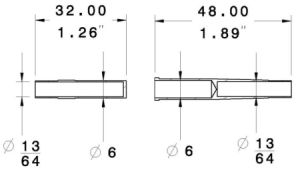
What I refer to as Regular Ferrules
are in fact Super Swiss type of ferrules that were developed long ago to allow the diameter of both
the tip and butt sections to be the same where they fit the ferrules, ie. a 13/64th ferrule means both sections of the rod are turned to 13/64ths
to fit the male and female ferrules. As basic as it gets.
They were seen as a technical advance upon Step Down ferrules where the bamboo has to be reduced in diameter a couple of 64ths inside the slide
section of the male.
This is definately an advantage when it comes to fitting them but I'm not sure the reduction in diameter of the bamboo inside the slide of Step Down
ferrules is as
bad as is sometimes thought because they don't in fact seem to fail as the metal of the slide is clearly strong enough to support the forces transfered
through the slide in use.
The disadvantage of Regular Ferrules is they are thicker than the bamboo so cause a swollen look on the rod as well as added stiffness to some degree and do
cause a noticeable amount of air resistance compared to Step Down ferules and they are heavier than Stepdowns.
If you look at the drawing above you'll see that the length of the female is 48mm long and the reamed male slide recess is 6mm in diameter.
I came up with these dimensions purely because of my taste of the aesthesics of the ratio and my personal preferance for longer rather
than shorter ferrules.
Nevertheless they are the most commonly used ferrules so I call them Regular Ferrules.
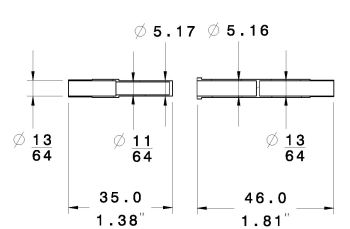
Step Down ferrules are the original design of ferrules.
My ferrules are machined so tube diameters or mandrels and dies are a non issue to me but originally and now ferrules would be drawn or made from tube which have a certain inside diameter or wall thickness. This would suit the fitting of the rod section of the female ferrule but the male slide had to fit inside the tube of the female ferrule so a step down or diameter reduction would have to be utilized to allow the male slide to fit the female.
The disadantage to this is a complication in fitting the tip section because you have to reduce the dia in two places to fit the large and small diameters of the male ferrule and the technical weakness of a reduced cross section of bamboo where it's reduced to fit the slide.
A look at the drawing of the Step Down ferrule shows that the female accepts a 13/64th dia rod section while the male takes 13/64th for part of the length then it reduces to 11/64ths at the slide.
The advantage is there is no swelling at the mid point of the rod because the ferrule is closer to the dimensions of the rod, there is less wind resistance than a Regular or Super Swiss style ferrule and it is lighter than a Regular ferrule. While the length of the female is still 46mm the reamed slide recess is only 5.16mm so is noticeably slimmer than a Regular ferrule, this also enhances the rod action it being less stiff than a Regular ferrule.
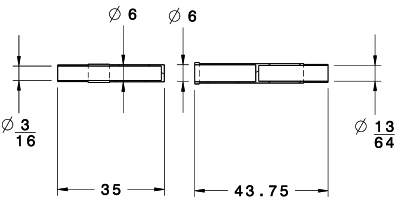
Many Dickerson and Payne tapers as well as other maker's rods have a smaller diameter tip than the butt (stepdown) at the ferrule.
This is a complication for non machined ferrules and if they were all there were available you would have to either use an undersized ferrule and undercut
the butt or oversized male and bulk out the tip.
As AV Young ferrules are machined it's a simple matter of making a 13/64th female to accept a Regular 12/64th male.
This means that so far as fitting is concerned you are simply fitting Regular style ferrules of 13/64 female and 12/64 male in our example. The stepdown is made in the female, not the male, so you do not have to be concerned with it at all.
Weight wise these are mid way between Regular style and Stepdown ferules.
If you make rods with drops in dimension between the butt and tip at the ferrule these are the ones to use.
Any other combination of sizes are also possible, just enquire.
As well as Dickerson tapers the excellent 6'8" 3 weight F.E.Thomas that has a step down from .170 to .158 at the tip requires a 11-10/64 of these types of ferrules for example.
It's worth mentioning that a few years ago I developed this style of ferrule for my own use that for lack of any better term I named Dickerson Style Ferrules because that's what I was making them for even though Dickerson himself never actually used them. It would appear as if I'm using Dickerson's name as a marketing ploy but in fact had I known they'd become as popular as they have I would have considered the name more but that's what they've become known as as.
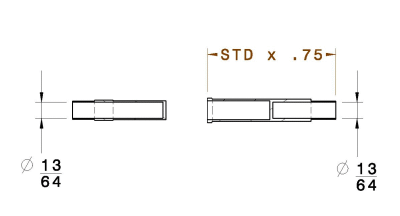
Truncated ferrules are Regular Ferrules reduced to
75% of the length of the female for that size with a corresponding reduction in the length of the male also.
Stepdowns and Dickerson Style ferrules are also available as Truncated.
48mm (length of a Regular 13/64 female ferrule) x 0.75 = 36mm, nothing more to it than that.
Some people use Truncated ferrules exclusively to save weight and achieve the rod action they preffer.
They are definately the ferrules to use on the tip section of a three piece rod at the very least.
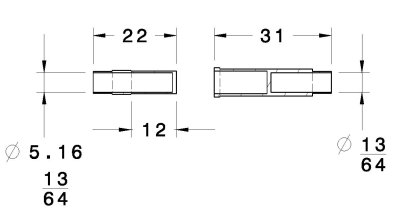
If ferrules were rifle cartridges Micro Ferrules would still be a
wild cat cartridge. Not for everybody
These are the last word on light weight metal ferrules with minimal affect on rod bending in use.
The criteria in the design of Micro Ferrules is that the male slide length is 2 times the diameter and everything else is pared down to the
minimum and that includes latitude in the fitting of the slide and glue surface area.
Clearly the subject of ferrules becomes a lot more involved once
you begin to delve into the relative merits of ferrule weight and the effects of rod action and I don't want to go into that as these are personal
ideas that everybody develops and as far as I can tell the maths behind attempting to determine these things on a moving rod is
inadaquate to the task and not worth the exercise considering there is a great deal of real world experience and opinion using the various ferrule designs.
If I may make a comment it would be that all of the different designs work. They all affect rod action in their own ways, you may like or dislike the
action a particular ferrule type imparts on a particular rod.
The only rule of thumb I would suggest is you should use truncated ferrules on at least the upper section of 3 piece rods and use stepdowns on rods
designed for them.
Many rodmakers' holy grail is to obtain an action as close to that of a one piece rod as possible while others including myself believe that all
ferrules impart a particular characteristic on the rod and that makes the action what it is.
Ultimately it's up to you the rodmaker and that's what makes this such an absorbing game that rodmakers play.
They are also very tricky to fit so recommended for experienced or very patient rodmakers looking for a rod action as close to a single piece
rod as possible for a two or more section rod.